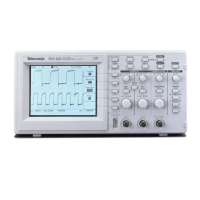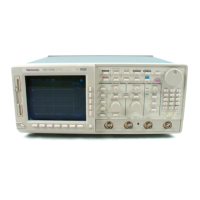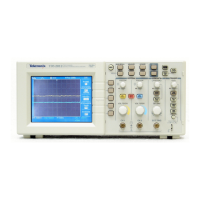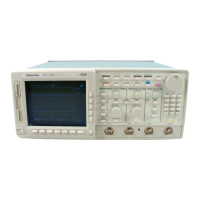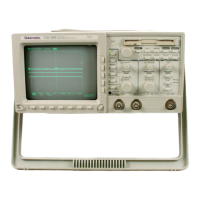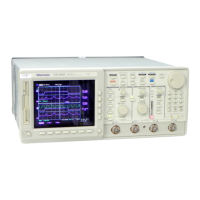Hardcopy
TDS 420A, TDS 430A, TDS 460A & TDS 510A User Manual
3–51
To send hardcopies to a floppy disk (see File System on page 3–43), do the
following steps:
1. Set up the digitizing oscilloscope communication and hardware parameters
as outlined in To Set Up for Making Hardcopies on page 3–47.
2. Insert a formatted 720 Kbyte or 1.44 Mbyte floppy disk into the disk slot of
the digitizing oscilloscope.
NOTE. See page 3–43 for information on formatting disks, deleting and renaming
files, setting overwrite lock, and using wild card characters.
3. Press SHIFT
➞ HARDCOPY MENU ➞ Port (main) ➞ File (side) to
specify that any hardcopy will be output to a file on the floppy drive. The
file list and its scrollbar will appear.
4. Turn the general purpose knob to place the scroll bar over the file in which to
store the hardcopy.
NOTE. Upon power on, the digitizing oscilloscope creates the “wild card” file
TEK?????.FMT for storing hardcopies, where “.FMT” is replaced by the
hardcopy format you select. Selecting this file and pressing Hardcopy stores a
hardcopy in a uniquely named, sequentially numbered file. For instance, the
digitizing oscilloscope saves the first hardcopy you save to the file
TEK00001.FMT, the second to TEK00002.FMT, and so on.
5. Display what you want on your hardcopy.
6. Press HARDCOPY to print your hardcopy to the selected file.
To make your hardcopies, use the procedures that follow.
Connect to a Hardcopy Device. To connect to a controller with two ports between
the digitizing oscilloscope and the hardcopy device, connect from the digitizing
oscilloscope GPIB connector (rear panel) to the controller GPIB port and from
the controller RS-232 or Centronics port to the hardcopy device (see Fig-
ure 3–29). Use the GPIB port to remotely request and receive a hardcopy from
the digitizing oscilloscope. Use the RS-232 or a Centronics port on the controller
to print output.
To Save to a Floppy Disk
To Print Using a Controller
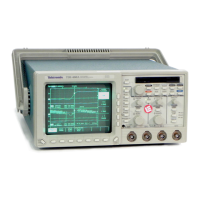
